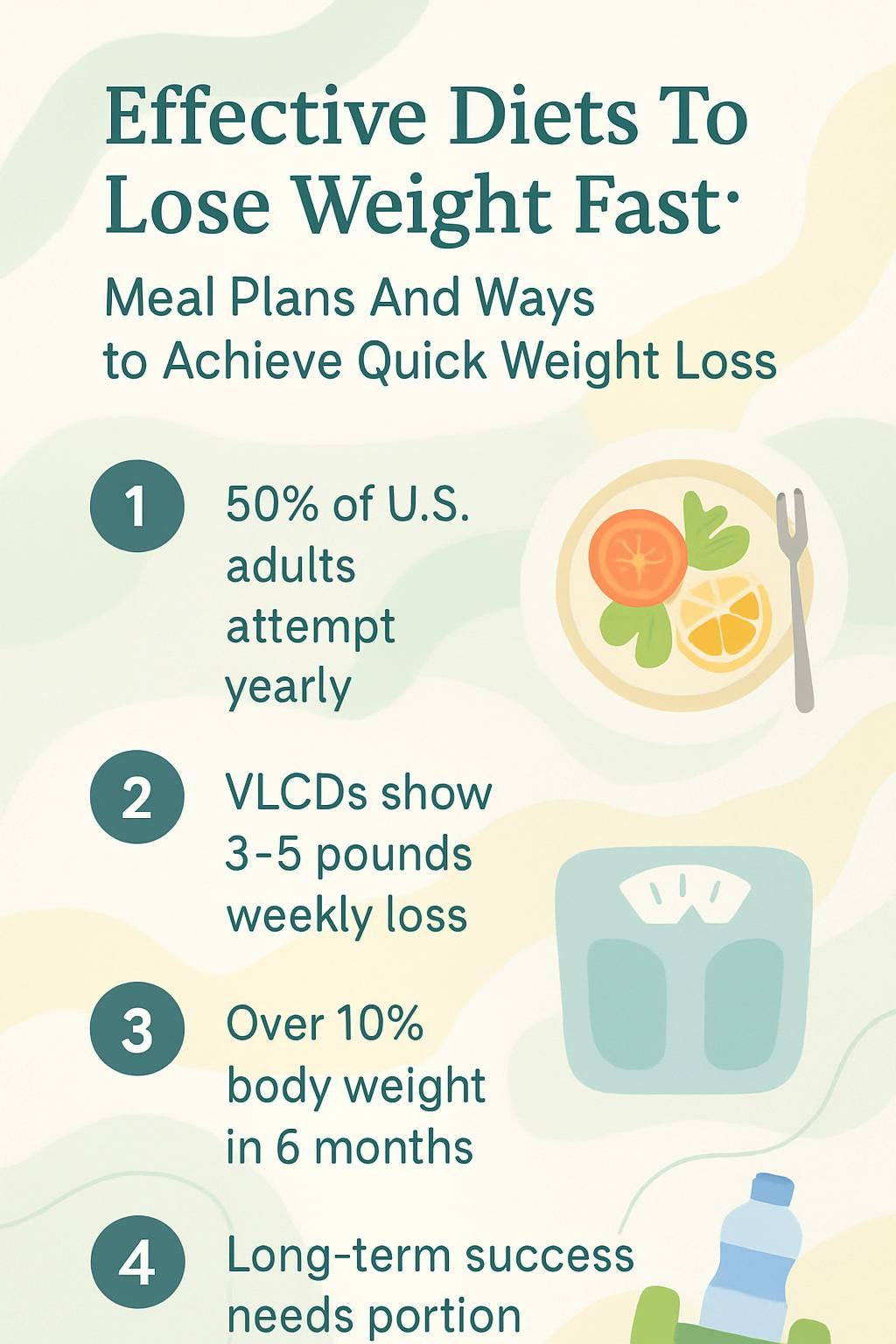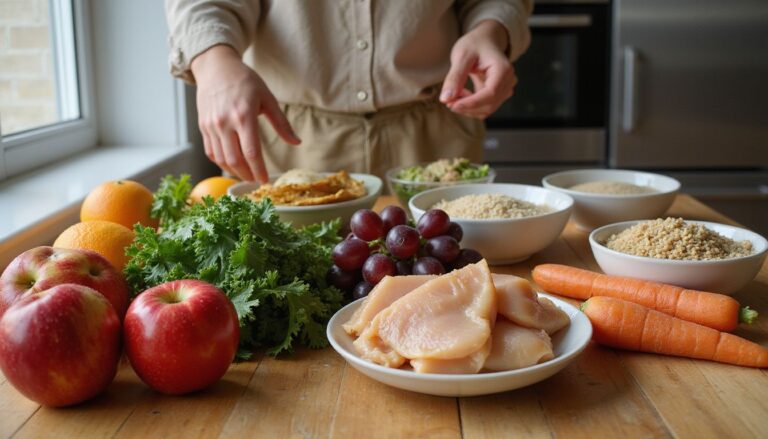Effective Diets To Lose Weight Fast: Meal Plans And Ways To Achieve Quick Weight Loss
Our Nutrition Assistant AI Suite will transform your body. You will lose fat, get toned, and build muscle. Gain confidence and optimal health.
Trying to lose weight can feel hard. You are not alone. About half of adults in the United States attempt weight loss each year, yet many still search for a diet that fits their life and goals.
This guide explains meal plans, evidence-based diets, and safe ways to speed progress. You will see how a clear diet strategy, such as a low-calorie diet or intermittent fasting, can help you reach a healthier weight without risking your health.
Keep reading for simple, science-backed steps you can apply today.
Key Takeaways
- About 50% of U.S. adults attempt weight loss each year. Very-low-calorie diets, about 800 calories per day, and low-calorie diets, roughly 1,000 to 1,500 calories per day, produce the fastest early results under medical guidance.
- Rapid loss means more than 2 pounds per week or over 10% of body weight in six months. The best outcomes come from a calorie deficit, regular physical activity, and structured meal plans like ketogenic or Mediterranean patterns.
- Clinical research, including Mayo Clinic Proceedings in 2016, reports medically supervised very-low-calorie diets can lead to 3 to 5 pounds lost per week for severe obesity.
- Intermittent fasting and time-restricted eating lower calorie intake. In Cell Metabolism (2019), an 8-hour eating window produced about 3% body weight loss in three months in adults with obesity.
- Long-term success depends on portion control, exercise, higher-protein meals, whole grains, healthy fats from avocados and nuts, and steering clear of restrictive fad diets.

What Is Rapid Weight Loss and What Affects It?

Rapid weight loss means losing a noticeable amount of body weight in a short time. Your age, health conditions, sleep, stress, and the type of eating plan you choose all influence your pace.
What does rapid weight loss mean?
Rapid weight loss usually means dropping more than 2 pounds per week. Health experts also describe it as losing over 10% of your body weight within six months. You often see fast changes when you sharply reduce calories or cut carbohydrates.
Losing weight too quickly can raise risks such as muscle loss and nutrient gaps, so medical advice is wise before you start.
During a two-week strict plan, I once lost 8 pounds. The scale moved fast, yet my energy dipped and workouts felt tougher.
Steady, realistic steps are easier to maintain and protect your health over time.
What factors influence quick weight loss?
Weight loss depends on energy balance. Eating fewer calories than you burn creates a calorie deficit, which triggers the body to use stored fat for fuel. Food choices matter too. Higher-protein meals, fewer processed foods, and more fruits and vegetables help control hunger and total intake.
Physical activity increases daily calorie burn. Whole grains, lean protein like chicken or fish, and produce support a nutrient-dense eating pattern. Health issues such as type 2 diabetes or thyroid problems, plus age, sleep, stress, medications, and hydration, also affect your rate of loss.
When I tracked my meals for the first time, I noticed portions were larger than I thought. That one habit change sped up progress without feeling deprived.
Key factors include:
- Calorie deficit
- Type of diet, such as low-carb or low-fat
- Physical activity level
- Sleep quality
- Stress management
- Underlying health conditions
- Hydration
Small swaps, like yogurt instead of a pastry at breakfast, add up. Together, these choices create a path to steady results.
Popular Diets Proven to Promote Quick Weight Loss
Several well-studied diets can help you lose excess weight faster while supporting good nutrition. Always consider your medical history and speak with a healthcare professional if you have conditions that affect eating or exercise.
What is a Very Low-Calorie Diet (VLCD)?
A very-low-calorie diet, or VLCD, provides 800 calories or fewer per day. It often uses meal replacement shakes, soups, or special products to deliver vitamins and minerals in a small calorie budget. Doctors use VLCDs for severe obesity or to prepare for surgery.
This approach requires medical supervision. Rapid loss can mean nutrient gaps, fatigue, gallstones, and muscle loss if not carefully managed. A review in Mayo Clinic Proceedings (2016) found weekly losses of about 3 to 5 pounds in clinical settings.
Under my doctor’s guidance, I used meal replacements for three months and lost nearly 30 pounds. My blood pressure also improved. Medical support made the plan safer and more effective.
How does a Low-Calorie Diet (LCD) work?
A low-calorie diet, or LCD, usually ranges from 1,000 to 1,500 calories per day. You create a calorie deficit by eating less than your body uses. Most people can expect about 1 to 2 pounds lost per week with a balanced LCD and exercise.
Typical LCDs include lean protein, whole grains, vegetables, fruit, and low-fat dairy foods. Tracking portions, limiting added sugar, and adding aerobic exercise help protect muscle while losing fat. If you have kidney disease, are pregnant, or take medications, talk with a healthcare provider before starting.
What are the benefits of the Ketogenic Diet?
The ketogenic diet is very low in carbohydrates, higher in fat, and moderate in protein. Cutting carbs shifts your body into ketosis, a state where fat becomes your main fuel instead of glucose. Many people see quick early losses, often from water, followed by fat loss if they stay consistent.
Research shows keto can lead to faster results than some low-fat diets in the first six months. Some people with type 2 diabetes report steadier blood sugar with fewer spikes. After two weeks on keto, I felt fewer cravings and steady energy with meals built from eggs, avocado, poultry, leafy greens, cheese, and nuts.
Keto can improve triglycerides and HDL cholesterol for certain people. The higher satiety may make it easier to stick with your plan.
Why choose the Mediterranean Diet for weight loss?
The Mediterranean diet focuses on vegetables, fruits, whole grains, beans, fish or poultry, nuts, and olive oil. It is balanced, flavorful, and rich in fiber and healthy fats. Studies show gradual losses of 5 to 10 pounds in a few months, along with lower belly fat and better heart health markers.
I turned to this approach after stricter plans left me tired. The variety kept meals interesting, and fiber reduced snack cravings. Sharing home-cooked Mediterranean-style meals also helped lower stress.
Some people pair this pattern with intermittent fasting for faster early results while keeping meals satisfying.
How does Intermittent Fasting help lose weight fast?
Intermittent fasting, or IF, limits the hours when you eat. A common method is 16 hours of fasting followed by an 8-hour eating window. Shorter eating windows can lower your daily calorie intake without strict calorie counting.
IF may reduce waist size and body weight within weeks. During fasting, your body uses stored fat for energy. Many people notice improved insulin sensitivity. A high-protein meal after a fast helps protect muscle while promoting steady fat loss.
What is Time-Restricted Eating and does it aid weight loss?
Time-restricted eating, or TRE, is a form of IF where you eat all meals within a set window, such as 10 a.m. to 6 p.m. You then fast for the remaining hours. In Cell Metabolism (2019), adults with obesity who used an 8-hour window lost about 3% of body weight in three months.
This pattern may support blood sugar control and appetite management. I used a noon-to-eight window last summer and noticed fewer late-night cravings. Morning workouts felt better with a consistent schedule.
Which Meal Plans Support Faster Weight Loss?
Structured meal plans can help you lose 1 to 2 pounds per week while still meeting dietary guidelines. Choose the pattern that fits your tastes and schedule so you can stick with it.
How do high-protein meal plans boost weight loss?
Protein increases fullness compared to carbs or fat. It also helps you keep lean muscle during calorie restriction. Studies show high-protein plans support about 1 to 2 pounds lost per week for many people.
Good options include chicken, fish, eggs, yogurt, and legumes. Your body uses more energy to digest protein, which gives a small calorie burn advantage. Switching to a higher-protein breakfast with Greek yogurt and nuts helped me reduce late-night chocolate cravings.
Are low-carb meal plans effective for losing weight?
Low-carb plans, such as the Atkins diet, limit bread, pasta, rice, and sugar. They focus on lean protein, healthy fats, and non-starchy vegetables. Research shows larger early losses in the first six months for many people compared with higher-carb plans.
These plans may help stabilize blood sugar and support weight management for those at risk of type 2 diabetes. If you have type 1 diabetes or are pregnant, speak with an endocrinology specialist before starting.
What balanced meal plans include portion control?
Balanced plans with portion control reduce calories without removing entire food groups. A simple plate guide works well: fill half with vegetables, one-quarter with lean protein, and one-quarter with whole grains or beans.
Use smaller plates and measuring cups to right-size servings. Keep starchy carbs near a fist in size and protein about the size of your palm. Portion control helps prevent overeating, supports better sleep, and lowers risks linked to obesity when paired with regular activity.
What Nutritional Foods Help With Weight Loss?
Nutrient-dense foods help you reach your goals faster. They provide volume and fiber for fullness while keeping calories reasonable.
Which leafy greens and cruciferous vegetables aid weight loss?
Leafy greens and cruciferous vegetables are low in calories and high in fiber and antioxidants. They increase fullness and improve the quality of your diet.
- Spinach delivers iron and vitamins A and C with very few calories.
- Kale provides glucosinolates, compounds studied for cell protection and healthy weight.
- Swiss chard offers magnesium and potassium that support muscles and heart health.
- Arugula adds peppery flavor and vitamin K for bones, helpful if you exercise.
- Broccoli is fiber rich and pairs well with lean protein to boost satiety.
- Cauliflower works as a rice or potato swap, cutting carbs while keeping portions large.
- Brussels sprouts bring antioxidants that support lower inflammation linked to stress.
- Cabbage is rich in vitamin C and fits salads, stir-fries, or soups.
Steamed broccoli before dinner helped me eat smaller portions and feel satisfied. These vegetables make your meals filling without adding many calories.
Why are lean proteins like chicken and fish important?
Lean proteins support fullness, protect muscle, and help regulate calories. They fit easily into most meal plans and support heart health when prepared with less added fat.
- Lean protein curbs hunger and reduces snacking.
- Chicken and fish are lower in calories than many red meats.
- Fatty fish supply omega-3 fats that support heart health.
- Skinless chicken breast provides high protein with little fat.
- Protein digestion burns slightly more calories than carbs or fat.
- Higher protein intake can increase fat loss when paired with exercise.
- Lean proteins limit saturated fat, which supports long-term health.
- During pregnancy, lean proteins supply key nutrients while controlling excess weight gain.
- Simple methods, such as grilling or baking, fit well with Mediterranean-style meals.
- Replacing processed meats with chicken or fish cuts sodium and preservatives.
How do whole grains and legumes contribute to weight loss?
Whole grains and legumes deliver fiber and protein that keep you satisfied. They digest slowly, steadying energy and appetite.
- Brown rice, oats, and quinoa provide complex carbs that help control hunger.
- Fiber promotes fullness. Most adults need 25 to 38 grams per day.
- Lentils, chickpeas, and black beans are rich in plant protein that protects muscle.
- Low glycemic index foods reduce spikes in blood sugar and cravings.
- Replacing refined grains with whole grains can lower obesity and diabetes risk.
- These foods supply iron, magnesium, zinc, and B vitamins for energy metabolism.
- They have lower calorie density, so you can eat satisfying portions without excess calories.
Pair whole grains and legumes with leafy greens and lean protein to build filling, balanced meals.
What healthy fats from avocados and nuts should I eat?
Healthy fats support vitamin absorption, steady energy, and meal satisfaction. Add small portions to meals to reduce cravings.
- About one-third of an avocado provides monounsaturated fat and potassium that may help reduce water retention.
- Almonds supply vitamin E and mostly unsaturated fat for heart health.
- Walnuts add omega-3 fats that support mood during stressful periods.
- Pecans and hazelnuts provide polyunsaturated fats linked to healthy cholesterol levels.
- Natural peanut butter offers protein and unsaturated fat. Choose options without added sugar or hydrogenated oils.
- Pistachios bring fiber and antioxidants that support a healthy body weight.
- Chia seeds add plant omega-3s. Blend them into smoothies or yogurt.
These fats fit well in the Mediterranean diet and support long-term heart protection.
How Does Exercise Accelerate Weight Loss?
Exercise boosts calorie burn and protects muscle while you diet. Think of it as a power partner for your healthy eating plan.
Why combine diet with physical activity for weight loss?
Combining a calorie deficit with regular activity leads to better results than either alone. People who do both often lose more body fat and improve health markers like blood pressure and blood sugar.
Exercise helps you keep muscle during weight loss. It also reduces stress and raises energy, which makes it easier to stick to your plan. If you are pregnant or have medical concerns, seek personal advice before changing your routine.
What types of exercises are best for losing weight?
Choose activities you enjoy so you can repeat them often. Mix different types through the week for the best effect.
- Cardio, such as brisk walking, running, cycling, or swimming, burns calories. Aim for 150 to 300 minutes weekly.
- High-intensity interval training, or HIIT, alternates hard efforts with rest and can speed fat loss in less time.
- Strength training builds muscle that burns more calories at rest. Try two sessions weekly.
- Group classes like Zumba, spin, or kickboxing offer structure and motivation.
- Everyday movement, such as gardening or dog walking, adds steady burn.
- Yoga and stretching improve flexibility and reduce injury risk.
- Step trackers and health apps keep you moving toward daily goals.
Fun activities feel less like chores and more like habits you can keep.
How important is consistency in exercise for weight loss?
Consistency is the driver of progress. Adults should aim for at least 150 minutes of moderate activity each week to lose or maintain weight, according to the CDC.
Scheduling workouts, tracking progress, and choosing enjoyable activities help you stay on track. Skipping sessions often slows momentum. Sticking with your plan keeps your body using fat for energy.
How Can You Sustain Weight Loss Long-Term?
Long-term success depends on realistic goals, steady habits, and a plan that fits your daily life.
How to set realistic weight-loss goals?
Clear, achievable goals keep you focused and motivated. Use simple steps to make progress easier to track.
- Set a specific target like “lose 10 pounds in three months.”
- Aim for 1 to 2 pounds per week, a safe and sustainable pace.
- Break your goal into small steps, such as tracking calories or adding a vegetable to one meal daily.
- Log meals and drinks in an app or journal to spot patterns.
- Celebrate small wins with non-food rewards, such as a new book or walking shoes.
- Adjust goals if you hit a plateau. Flexibility keeps you moving forward.
- Share progress with friends or a support group for accountability.
- Focus on nutritious foods, portions, and daily movement. Small changes build strong habits.
- Avoid fad diets that promise fast results without solid science.
- Consult a healthcare professional before major changes, especially if you manage health conditions.
These steps make goals clear and attainable while protecting your health.
What are healthy eating habits to build for weight loss?
Healthy eating habits make weight loss easier and help you maintain results. Build them one at a time so they stick.
- Eat regular meals to prevent extreme hunger and overeating.
- Use smaller plates and measure foods to control portions.
- Choose whole foods, such as vegetables, fruits, lean protein, beans, nuts, and whole grains.
- Drink water instead of sugary beverages. Aim for at least 8 cups daily.
- Prioritize fiber-rich foods to improve fullness and digestion.
- Cook at home more often to control ingredients and portions.
- Limit fast food, sweets, and ultra-processed snacks.
- Track intake with a journal or app to stay aware of habits.
- Pause and check hunger cues before getting seconds.
- Include a lean protein source in every meal to protect muscle.
- Eat slowly and put away screens so you notice fullness.
These tactics make your plan practical, satisfying, and sustainable.
Why should you avoid fad diets?
Fad diets often cut entire food groups or set strict rules. They can cause quick drops on the scale, yet most people regain the weight within a year. You may miss key nutrients like iron, calcium, and vitamins if you stay on them too long.
Very low calorie intake can slow your metabolism and lead to muscle loss. Strict plans raise the risk of rebound eating because they are hard to keep. Balanced, evidence-based approaches are safer and last longer.
What Are the Health Benefits of Effective Weight Loss?
Effective weight loss can improve how you feel, how you move, and your long-term health.
How does effective weight loss enhance overall health?
Losing 5 to 10% of your body weight can lower risks for heart disease, type 2 diabetes, high blood pressure, and some cancers. Less weight reduces stress on joints and can ease arthritis pain.
Sleep often improves as extra weight around the airway decreases. Many people also report higher confidence and motivation. After dropping fifteen pounds with a structured plan and daily walks, I noticed more stamina on hikes and better focus at work.
Can weight loss lower the risk of chronic diseases?
Yes. Even modest weight loss can improve blood sugar, cholesterol, and blood pressure. It can also reduce inflammation, which supports heart and metabolic health.
Doctors often recommend nutrient-dense meal plans with portion control to lower triglycerides and improve insulin sensitivity. Filling your plate with leafy greens, lean proteins, and whole grains adds protection against diseases linked to obesity.
How does losing weight boost energy and mental well-being?
With less excess weight, your heart works more efficiently and blood flow improves. Daily tasks feel easier, and exercise becomes more comfortable.
Research from Harvard suggests people who lose 5 to 10% of body weight often report improved mood and self-esteem.^1 When my energy stabilized after losing fifteen pounds, I could concentrate longer and felt less worried about health risks.
Fast methods still carry risks if not well planned. Protect nutrition and muscle as you lose.
What Are the Risks of Rapid Weight Loss?
Rapid approaches can raise health risks if the plan is not supervised or balanced. Make safety your first priority.
What nutritional deficiencies can rapid weight loss cause?
Severe calorie cuts make it hard to meet daily nutrient needs. These shortfalls can affect energy, immunity, and bone health.
- Too little protein can cause muscle loss and slow metabolism.
- Low iron raises the risk of anemia and fatigue.
- Low calcium may weaken bones and increase fracture risk.
- Low vitamin B12 can cause weakness or numbness.
- Electrolyte imbalances, such as low sodium or potassium, can cause cramps or heart issues.
- Low folate is risky for women of childbearing age.
- Low zinc can slow wound healing and weaken immunity.
- Low vitamin D may cause muscle weakness and bone pain.
- Too little essential fat can lead to dry skin, hair loss, and hormone issues.
- Low magnesium can cause muscle twitching or irregular heartbeat.
Balanced meal plans with a variety of whole foods help prevent these problems.
How does rapid weight loss lead to muscle loss and fatigue?
During large calorie deficits, the body may use muscle for energy if protein is low or resistance training is missing. Losing muscle lowers your metabolism because muscle tissue burns more calories at rest than fat.
You may feel tired as your body struggles to get enough energy. I once lost fifteen pounds in a month without a plan, and workouts became exhausting. Electrolyte shifts can add cramps and fatigue. Add protein and strength training to protect muscle as you lose.
What effects does rapid weight loss have on metabolism?
Rapid loss often slows your resting metabolic rate, sometimes by 15% on very low-calorie diets. Your body adapts to fewer calories and burns less at rest.
If you lose muscle during the process, your daily burn drops even more. I followed a strict plan for two months and regained quickly once I returned to normal eating. Hormones that control hunger and fullness can also shift, which makes appetite harder to manage.
Protect your metabolism with adequate protein, strength training, and a moderate calorie deficit.
What Are the Best Tips for Safe Quick Weight Loss?
Use nutrition science to speed results while protecting your health. Small, smart steps lead to steady change.
Why is staying hydrated important for quick weight loss?
Water supports metabolism and appetite control. Drinking 500 milliliters of water can raise metabolic rate for about an hour in some studies. Thirst can feel like hunger, which may trigger snacking.
During low-calorie phases, staying hydrated helped me avoid cravings and stick to my plan. Water also aids digestion and helps your body clear waste. These factors matter even more when you are losing weight quickly.
How can monitoring portion sizes help lose weight fast?
Portion control reduces calories without cutting favorite foods completely. Using smaller plates makes meals look fuller and helps you feel satisfied with less.
In one study, adults who reduced portions lost more weight than those who did not change serving sizes. Weighing food or checking labels gives accurate calorie counts. When I tracked portions for two weeks, I realized even healthy foods add up in large amounts.
Why should processed and sugary foods be cut out?
Processed foods often contain added sugar, unhealthy fats, and excess sodium. They cause blood sugar spikes that increase cravings. The CDC notes many people consume more added sugar than recommended each day.
Sugar-sweetened drinks add calories without nutrition. Diets high in ultra-processed foods raise the risk of obesity and metabolic disease. Skipping chips, pastries, and candy made it easier for me to avoid mindless snacking. Choosing whole foods such as vegetables, fruit, lean protein, and whole grains supports faster progress.
What Are Common Myths About Fast Weight Loss?
Myths spread quickly, but the best results come from simple, proven habits that you can maintain.
How to challenge misconceptions about fad diets?
Fad diets promise quick results but rarely last. Extreme rules, single-food plans, and cleansing routines often lead to regain. Studies show most people recover lost weight within a year after stopping a fad plan.
Explain that balanced eating with lean protein, vegetables, whole grains, and healthy fats supports steady fat loss and health. I tried a juice cleanse once and felt hungry and tired, not energized. Sustainable habits prevent plateaus and keep you moving forward.
What causes weight-loss plateaus and how to overcome them?
Plateaus happen as your body adapts to fewer calories and more exercise. Your metabolism may slow, hunger hormones can shift, and muscle loss can reduce your daily burn.
To break a plateau, adjust calories slightly, vary workouts, or increase intensity. Add strength training and increase protein to protect muscle. Track food choices to spot patterns. When my low-carb progress stalled, I alternated HIIT with resistance training and added lean protein to each meal. Within weeks, the scale started moving again.
New routines challenge your body so it does not adapt too quickly.
Conclusion
Choosing an evidence-based diet and a clear meal plan can speed weight loss and help you keep it off. Options like a low-calorie diet, intermittent fasting, or higher-protein meals give you workable paths. Pair your plan with exercise, portion control, whole grains, and fewer processed foods for the best results.
Fast fixes can be risky. Focus on safe steps, steady habits, and medical guidance when needed. Real change takes time, yet these strategies help you build a healthier life with benefits that last.
Medical disclaimer: This article is for education only and is not medical advice. Consult a qualified healthcare professional before starting any diet, supplement, or exercise program, especially if you have health conditions or take medications.
FAQs
1. What are the most effective diets for quick weight loss?
Research shows that structured eating plans like low-carbohydrate, Mediterranean, and high-protein regimens can help people lose pounds quickly. A study in The New England Journal of Medicine found that participants on a low-carb plan lost more weight over six months than those on a low-fat plan.
2. How do meal plans support fast weight loss?
Meal planning helps control calorie intake and ensures balanced nutrition. For example, a daily menu with lean poultry or fish, whole grains such as brown rice, and plenty of vegetables provides essential nutrients while reducing overall calories.
3. Are rapid weight-loss methods safe for everyone?
Not all quick approaches suit every person. Medical experts recommend consulting a healthcare provider before starting any new regimen to ensure safety based on individual health needs or conditions.
4. Can personal experience improve success with diet changes?
Personal stories often highlight practical strategies such as keeping healthy snacks available or tracking meals each day; these habits can increase motivation and accountability during the process.
Summary: Evidence supports several eating patterns for losing pounds quickly when paired with careful planning and professional advice. Structured menus guide food choices while real-life examples show how small actions make lasting change possible.







